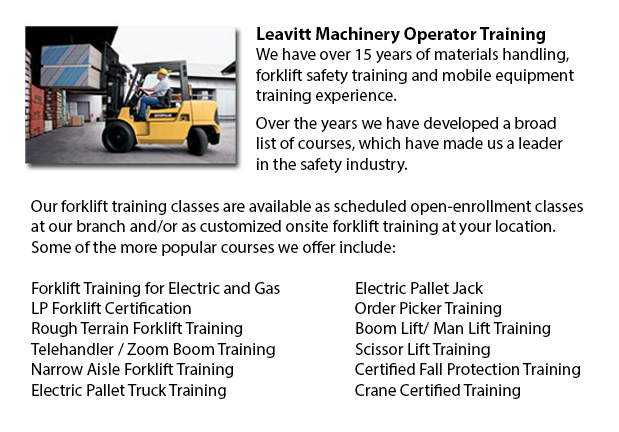
Forklift Training Programs Goodyear - If you are searching for work as a forklift operator, our regulatory-compliant forklift training programs offer exceptional instruction in various types and styles of lift trucks, lessons on pre-shift check, fuel types and dealing with fuels, and safe utilization of a lift truck. Practical, hands-on training assists participants in acquiring basic operational skills. Program content comprises existing regulations governing the utilization of forklifts. Our proven forklift courses are designed to offer training on these kinds of trucks: narrow isle forklift, counterbalanced forklift and powered pallet truck.
How to Safely Handle Loads
Do not raise or lower the fork while the forklift is traveling. A load must not extend above the backrest due to the danger of the load sliding back toward the operator. Inspect for overhead obstacles and ensure there is adequate clearance prior to lifting a load. Stay away from overhead power lines. When the load is lifted straight up, tilt it slightly back.
The lift truck is less steady if a load is in a raised position. Ensure that no body ever walks underneath the elevated fork. The operator must never leave the lift truck when the load is raised.
While handling pallets, forks should be level and high enough to go into the pallet and extend all the way below the load. The width of the forks should provide even weight distribution.
Set the brakes and chock the wheels prior to loading and unloading the truck. The floors should be strong enough to support the weight of both the load and the forklift. Fixed jacks can be installed to support a semi-trailer that is not attached to a tractor. The entrance door height must clear the forklift height by at least 5 cm. Mark edges of ramps, docks or rail cars and avoid them.
If there is not proper ventilation into the forklift, do not stay in there for extended periods. The trucks interior must have enough lighting and be obstruction free. Inspect the flooring of the forklift cab for holes. The installation of material which are non-slip on the floor would help prevent slipping. Clear any obstructions from dockplates and docks and ensure surfaces are not wet or oily.
Never push or tow other vehicles making use of a lift truck.
-
Crane / Overhead Crane / Truck Mounted Crane / Hydraulic Cranes Training in Goodyear
Bridge cranes or likewise called overhead cranes are a kind of industrial material handling crane making use of a line and hook device that runs on a horizontal beam running along two widely separated rails. Many overhead cranes can be seen inside a... More -
Fantuzzi Parts
The Italian Fantuzzi Group offers a glut of material handling equipment and heavy machinery. The equipment consists of numerous equipment specializing in transporting, loading and unloading goods. The railway freight sector and the port authority req... More -
Forklift Training School Goodyear
Forklift Training School Goodyear - Why A Forklift Training School Could Actually Help A Business And Its Employees - CSA and OSHA establish criteria for forklift safety training that meets existing regulations and standards. Anyone intending to oper... More -
Warehouse Forklift Training Classes Goodyear
Warehouse Forklift Training Classes Goodyear - The purpose of warehouse training classes are to raise the awareness of common workplace hazards. The trainees would learn necessary warehouse safety measures. An emphasis is placed on paying attention t... More -
Aerial Lift Ticket Goodyear
Aerial Lift Ticket Goodyear - A boom truck is frequently recognized by the cable and phone business vehicles that have the long arm folded over their roofs. Usually, a bucket-like apparatus sits at the extension of extendable arms. Sometimes termed a... More -
Telehandler Ticket Goodyear
Telehandler Ticket Goodyear - The telescopic handler or telehandler is a generally used equipment in agricultural and industrial applications. This machine is similar in look to a forklift and even works in a similar way, even though telehandlers are... More -
Scissor Lift Safety Training Goodyear
Scissor Lift Safety Training Goodyear - A Scissor Lift is a practical type of platform that normally moves in a vertical direction. The equipment is capable of this movement because of the use of folding supports that are linked in a criss-cross patt... More -
Aerial Boom Lift Training Goodyear
Aerial Boom Lift Training Goodyear - For individuals who operate or supervise the use of aerial lift platforms, right aerial boom lift Training is necessary. The aerial lift platform is for lifting individuals, materials and tools to elevated work lo... More

Forklift Training Goodyear
TOLL FREE: 1-888-254-6157
Goodyear, Arizona
forkliftcertificationgoodyear.com
Email Us
About Us


